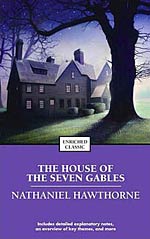
![]() jynnantonnyx
jynnantonnyx
1/2/2013
![]()
My introduction to the genre of Gothic Fiction was actually made not by a novel or short story, but by a graphic novel. Unlike the films, Mike Mignola’s Hellboy series is a dark and moody walk through crumbled castles and vine-ridden monasteries, albeit with the occasional gun fight and mad Nazi scientist. Reading it got me in the mood for more of the same, and after some research I discovered that Mignola was playing with a genre that’s been around for quite some time. The addition of the Guardian List brought with it a large selection of Gothic fiction to the WWEnd site, including one novel by an author I was already familiar with, Nathaniel Hawthorne.
By the time Hawthorne wrote his very popular House of the Seven Gables, he was working within an established genre whose shape and borders had already been established by such writers as Horace Walpole, William Beckford, Matthew Lewis, Charles Maturin, and Edgar Allan Poe. Hawthorne doesn’t disappoint any reader who comes to his novel expecting the same as what these earlier writers provided: ancient aristocratic homes, tyrannous judges, estranged relatives, unspeakable crimes from long ago, one-sided depictions of ancient religious communities, and of course a good haunting. While his book was and is well loved, I’m not sure that I agree with those who love it.
But the fault isn’t, I think, with the genre itself. Even though this is probably the only novel I’ve read that accurately conforms to the classical tropes of the Gothic genre—authors like Bram Stoker and of H.P. Lovecraft wrote books similar to the Gothic, but were developing their own ideas—I still have a strong draw to its peculiar atmosphere. Hawthorne, though, is something of a hack writer, and that harms the novel. Never content to allow a metaphor to remain implicit, he often spends multiple pages explicating an image he just inserted into the narrative, as though afraid its meaning might possibly pass a reader by. His prose is hardly bad in and of itself, but he can’t stop himself from pointing out his own cleverness. Adding to this weakness is his proclivity for digression, in which he interrupts an ongoing part of the narrative to talk about a character’s or object’s history, or to wax so poetic about something or other that the wax starts dripping all over the place. But for all his literary gurning, Hawthorne leaves a hugely important occurrence at the end of the narrative unexplained even after so much else is revealed. Sometimes one wishes he would shut up and tell the story.
Here’s part of Hawthorne’s description of the eponymous house:
All, as they approached, looked upward at the imposing edifice, which was henceforth to assume its rank among the habitations of mankind. There it rose, a little withdrawn from the line of the street, but in pride, not modesty. Its whole visible exterior was ornamented with quaint figures, conceived in the grotesqueness of a Gothic fancy, and drawn or stamped in the glittering plaster, composed of lime, pebbles, and bits of glass, with which the woodwork of the walls was overspread. On every side the seven gables pointed sharply towards the sky, and presented the aspect of a whole sisterhood of edifices, breathing through the spiracles of one great chimney. The many lattices, with their small, diamond-shaped panes, admitted the sunlight into hall and chamber, while, nevertheless, the second story, projecting far over the base, and itself retiring beneath the third, threw a shadowy and thoughtful gloom into the lower rooms. Carved globes of wood were affixed under the jutting stories. Little spiral rods of iron beautified each of the seven peaks.
Although The House of the Seven Gables is probably not the best example of Gothic fiction, its influence, especially on American horror, cannot be denied. Hawthorne himself is something of an acquired taste, but I know many people who think he’s one of the finest literary figures from early America. Maybe someday I’ll come around to their way of thinking, but it might be a while.
http://blog.worldswithoutend.com/2011/10/month-of-horrors-the-house-of-the-seven-gables/